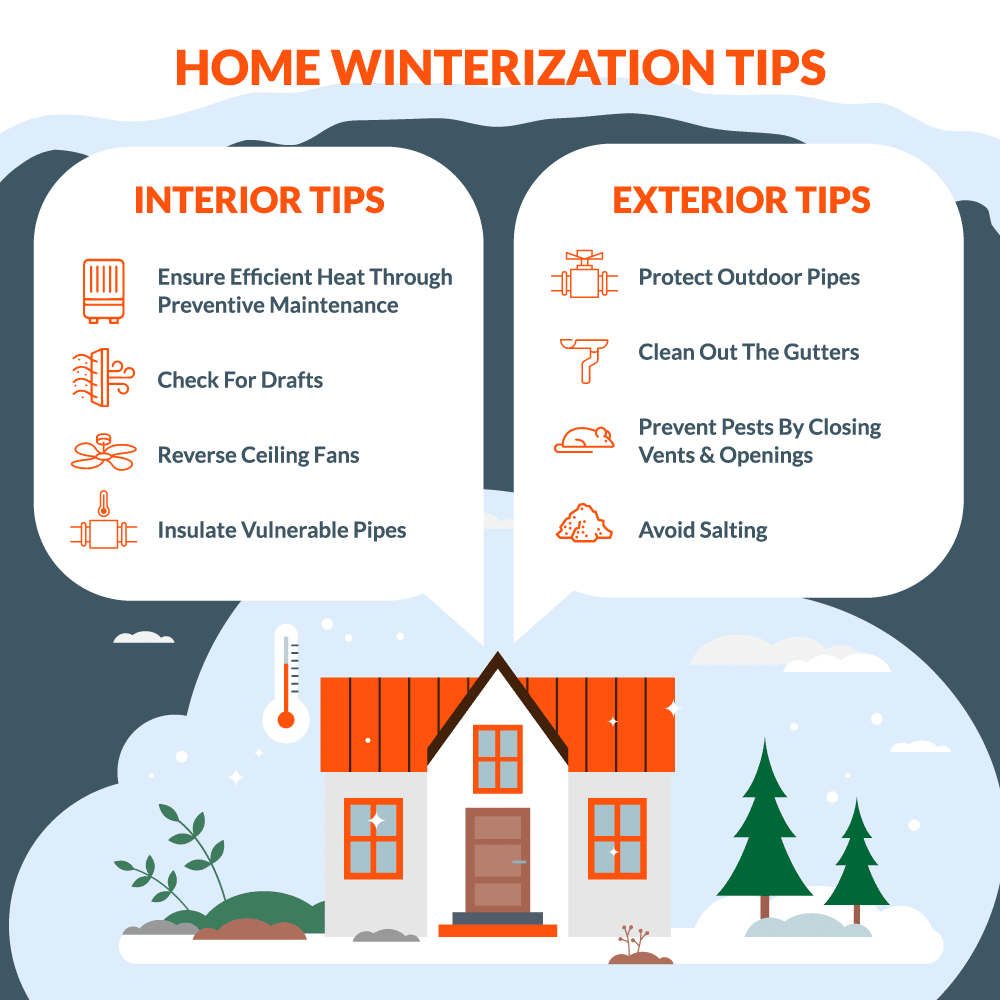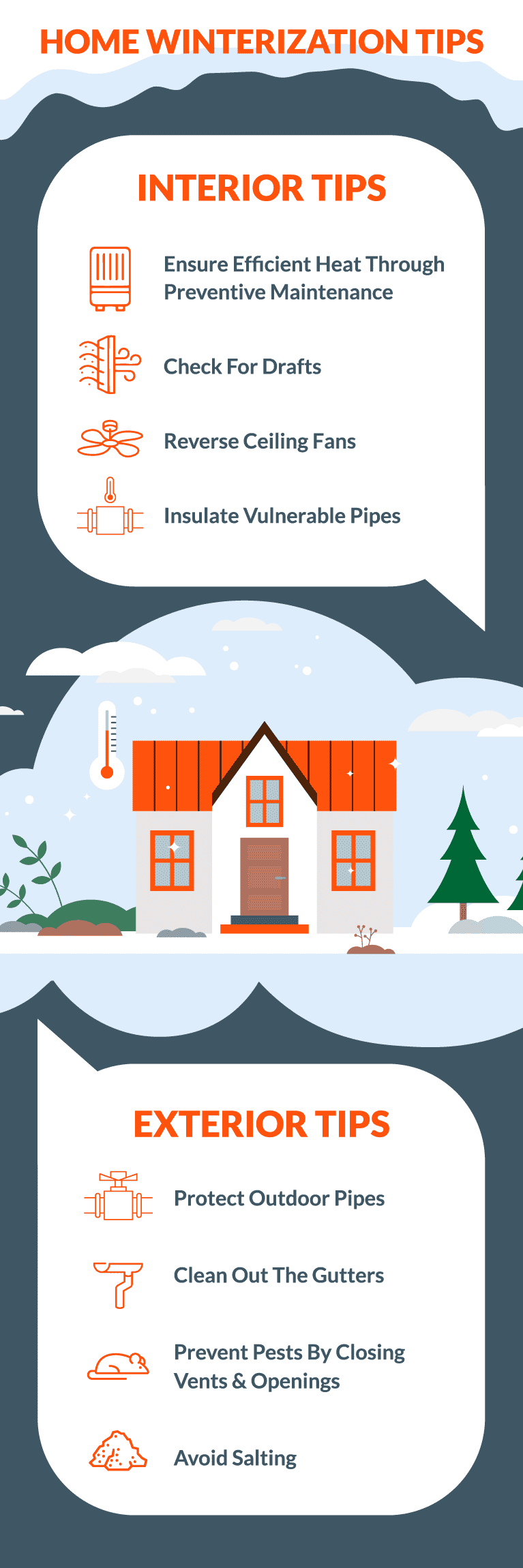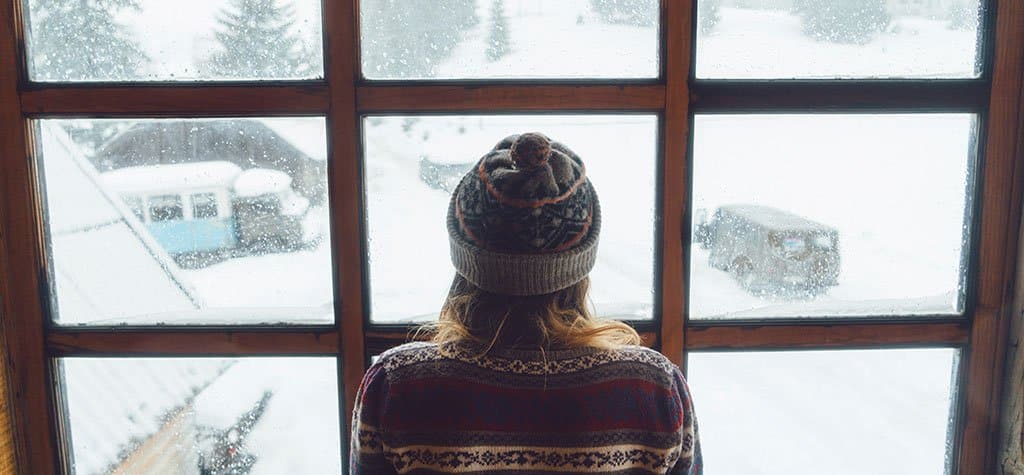We’re fortunate to live in a region graced by all four seasons, but with dropping temperatures comes many home-damaging hazards. With winter right around the corner, we encourage homeowners to take the time to protect their investment with these home winterization tips.
Even if you’re not quite ready for winter, there are some simple steps you can take to make sure your home is. And most of them are no cost to you, other than a little bit of your time.
Following these home winterization guidelines will help you (and your home) weather the winter season with ease:


Interior Home Winterization Care
Ensure Efficient Heating
When it comes to your heating and airing system, preventative servicing is much cheaper than costly breakdowns — just don’t wait until the coldest day of the year when everyone else has the same idea. It’s best practice to get in the habit of having your furnace or heat pump inspected annually.
Another hazard of a poorly functioning furnace is carbon monoxide (CO) emissions, a dangerous, odorless gas you don’t want in your home. A dirty or inefficient furnace can release unsafe levels of CO, but another bonus of regular servicing is that CO inspections are usually included.
These ‘tune-ups’ can save you thousands of dollars and help keep your furnace working hard for years to come.
Dodge Drafts
Another good practice is to do a quick check for drafts around all your windows, doors, and exposed ducts in basements, attics, and crawl spaces. You can use a sealant, like silicone caulk, to plug any air leaks.
Run Fans in Reverse
To make the most of the heat inside your home, reverse your ceiling fans and run them on lower speeds. Operating clockwise helps to lift cool air towards the ceiling and pull the warm air back down.
Prep Your Pipes
A 1/8-inch crack in a pipe can spew up to 250 gallons of water a day, causing flooding, serious structural damage, and the immediate potential for mold (State Farm). Protecting your water pipes is a preventative measure you don’t want to risk skipping.
Exposed pipes, usually found in your attic or crawl space, are the most vulnerable to freezing. You can insulate these with foam sleeves or heat tape — be sure to include pipes between the hot-water tank and wall. We’d also recommend insulating cold-water pipes for the first 3 feet after they enter the house.
Many newer homes have pipes specially created to prevent freezing, but if the worst does happen and your pipes burst, does everyone in your home know how to turn the water off at the source? It’s a good idea to walk everyone through this process and have a plan (just in case).
Exterior Home Winterization Care
Outdoor Pipe Precautions
One of the easiest things you can do is make sure to turn off exterior faucets, unhook garden hoses and store them indoors, and, if possible, shut off the water valve leading to these faucets.
Avoid Gutter Trouble
Cleaning out your gutters is probably already on your routine to-do list, but you’ll want to make sure it’s a priority before winter is in full swing. Inspecting them and cleaning out debris help prevent ice dams and the damage that comes with them — if your gutter isn’t secured properly, the weight of ice (and whatever else is lingering in there) could pull your gutters right off your house.
Additionally, make sure your gutter downspouts extend away from the house by at least 5 feet. The water damage from snowmelt can be serious enough to cause flooding, which can be damaging to your foundation.
Animal Control
Ensure all vents and openings are covered to prevent insects, birds, and rodents from getting inside — they’re all looking for a warm place to nest this time of year.
Avoid Salting
We can’t express enough NOT to use salt on any concrete or asphalt, i.e driveways, porches, or patios. It’s corrosive and will eventually, if not immediately, cause damage to concrete or asphalt.
Carbon monoxide leaks, pricy heating bills, flooding, and costly repairs are all reasons to take home winterizing very seriously. These precautions will help keep the cold out, the heat in, and your home safe.




